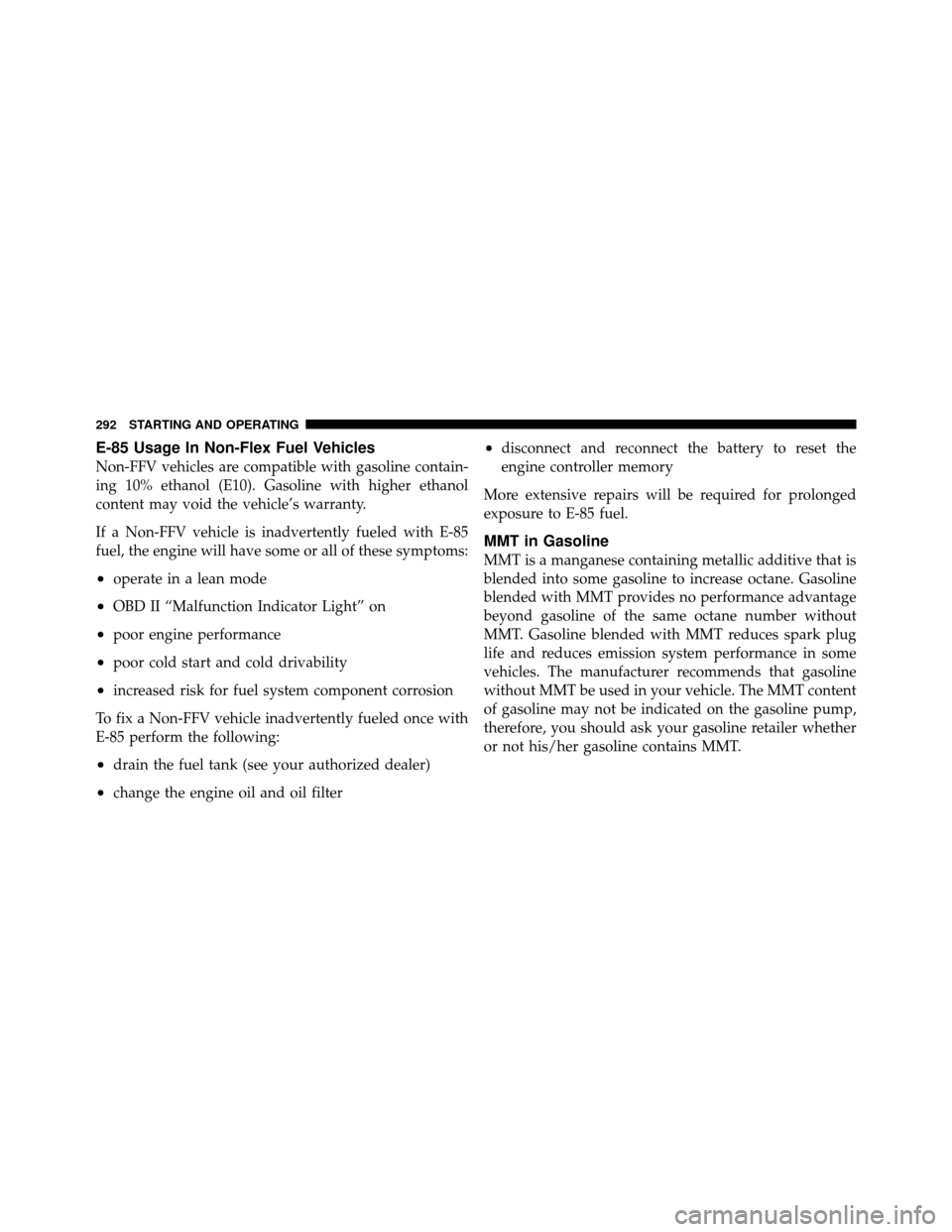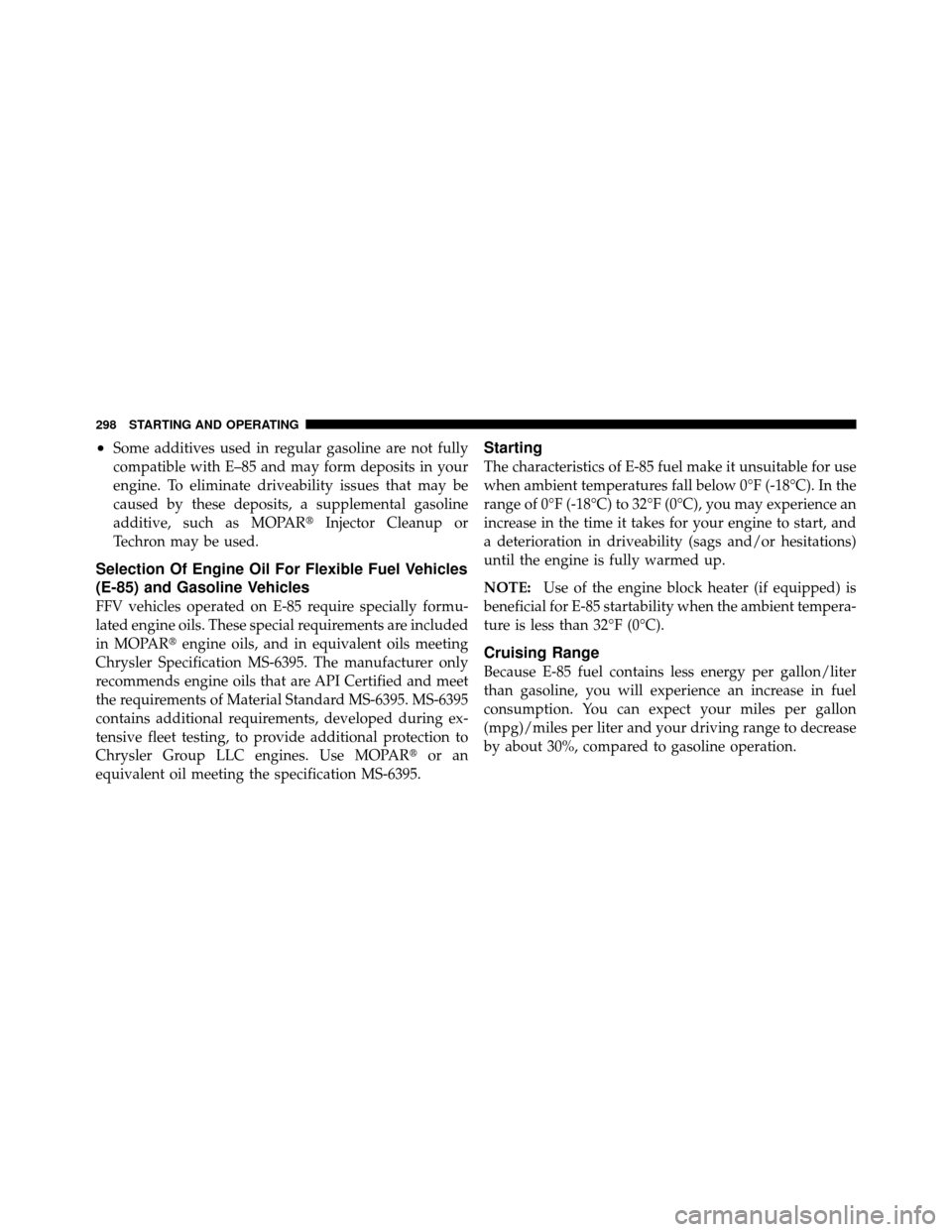Page 292 of 436

E-85 Usage In Non-Flex Fuel Vehicles
Non-FFV vehicles are compatible with gasoline contain-
ing 10% ethanol (E10). Gasoline with higher ethanol
content may void the vehicle’s warranty.
If a Non-FFV vehicle is inadvertently fueled with E-85
fuel, the engine will have some or all of these symptoms:
•operate in a lean mode
•OBD II “Malfunction Indicator Light” on
•poor engine performance
•poor cold start and cold drivability
•increased risk for fuel system component corrosion
To fix a Non-FFV vehicle inadvertently fueled once with
E-85 perform the following:
•drain the fuel tank (see your authorized dealer)
•change the engine oil and oil filter
•disconnect and reconnect the battery to reset the
engine controller memory
More extensive repairs will be required for prolonged
exposure to E-85 fuel.
MMT in Gasoline
MMT is a manganese containing metallic additive that is
blended into some gasoline to increase octane. Gasoline
blended with MMT provides no performance advantage
beyond gasoline of the same octane number without
MMT. Gasoline blended with MMT reduces spark plug
life and reduces emission system performance in some
vehicles. The manufacturer recommends that gasoline
without MMT be used in your vehicle. The MMT content
of gasoline may not be indicated on the gasoline pump,
therefore, you should ask your gasoline retailer whether
or not his/her gasoline contains MMT.
292 STARTING AND OPERATING
Page 298 of 436

•Some additives used in regular gasoline are not fully
compatible with E–85 and may form deposits in your
engine. To eliminate driveability issues that may be
caused by these deposits, a supplemental gasoline
additive, such as MOPAR�Injector Cleanup or
Techron may be used.
Selection Of Engine Oil For Flexible Fuel Vehicles
(E-85) and Gasoline Vehicles
FFV vehicles operated on E-85 require specially formu-
lated engine oils. These special requirements are included
in MOPAR� engine oils, and in equivalent oils meeting
Chrysler Specification MS-6395. The manufacturer only
recommends engine oils that are API Certified and meet
the requirements of Material Standard MS-6395. MS-6395
contains additional requirements, developed during ex-
tensive fleet testing, to provide additional protection to
Chrysler Group LLC engines. Use MOPAR� or an
equivalent oil meeting the specification MS-6395.
Starting
The characteristics of E-85 fuel make it unsuitable for use
when ambient temperatures fall below 0°F (-18°C). In the
range of 0°F (-18°C) to 32°F (0°C), you may experience an
increase in the time it takes for your engine to start, and
a deterioration in driveability (sags and/or hesitations)
until the engine is fully warmed up.
NOTE: Use of the engine block heater (if equipped) is
beneficial for E-85 startability when the ambient tempera-
ture is less than 32°F (0°C).
Cruising Range
Because E-85 fuel contains less energy per gallon/liter
than gasoline, you will experience an increase in fuel
consumption. You can expect your miles per gallon
(mpg)/miles per liter and your driving range to decrease
by about 30%, compared to gasoline operation.
298 STARTING AND OPERATING
Page 315 of 436
WHAT TO DO IN EMERGENCIES
CONTENTS
�Hazard Warning Flasher ................ 316
� If Your Engine Overheats ................ 316
▫ Engine Oil Overheating
(2.4L Engine Only) — If Equipped ........ 317
� Jacking And Tire Changing ............... 318
▫ Jack Location ....................... 318
▫ Spare Tire Stowage ................... 318
▫ Preparations For Jacking ............... 319
▫ Jacking Instructions ................... 320
� Jump-Starting Procedure ................ 325 �
Freeing A Stuck Vehicle ................. 328
� Towing A Disabled Vehicle ............... 329
▫ Towing With The Ignition Key ........... 329
▫ Towing Without The Ignition Key ........ 330
▫ Towing This Vehicle Behind
Another Vehicle ..................... 331
▫ Towing This Vehicle Behind Another Vehicle
With A Tow Dolly .................... 331
▫ Towing Without Power — Override
Transaxle Interlock System .............. 331
6
Page 317 of 436

NOTE:There are steps that you can take to slow down
an impending overheat condition:
•If your air conditioner (A/C) is on, turn it off. The A/C
system adds heat to the engine cooling system and
turning the A/C off can help remove this heat.
•You can also turn the temperature control to maximum
heat, the mode control to floor and the blower control
to high. This allows the heater core to act as a
supplement to the radiator and aids in removing heat
from the engine cooling system.
WARNING!
A hot engine cooling system is dangerous. You or
others could be badly burned by steam or boiling
coolant. You may want to call a service center if your
vehicle overheats. If you decide to look under the
hood yourself, refer to Section 7, Maintenance, of this
manual. Follow the warnings under the Cooling
System Pressure Cap paragraph.
Engine Oil Overheating (2.4L Engine Only) — If
Equipped
During sustained high-speed driving or trailer tow up
long grades on a hot day, the engine oil temperature may
become too hot. If this happens, the “HOTOIL” message
flashes in the odometer and the vehicle speed will be
reduced to 53 mph (85 km/h) until the engine oil
temperature is reduced.
6
WHAT TO DO IN EMERGENCIES 317
Page 333 of 436
MAINTAINING YOUR VEHICLE
CONTENTS
�Engine Compartment — 2.4L ............. 335
� Engine Compartment — 2.7L ............. 336
� Engine Compartment — 3.5L ............. 337
� Onboard Diagnostic System — OBD II ...... 338
▫ Loose Fuel Filler Cap Message ........... 338
� Emissions Inspection And Maintenance
Programs ............................ 339
� Replacement Parts ..................... 340
� Dealer Service ........................ 341 �
Maintenance Procedures ................. 341
▫ Engine Oil ......................... 342
▫ Engine Oil Filter ..................... 345
▫ Engine Air Cleaner Filter ............... 346
▫ Maintenance-Free Battery .............. 346
▫ Air Conditioner Maintenance ............ 348
▫ A/C Air Filter — If Equipped ........... 349
▫ Body Lubrication .................... 350
▫ Windshield Wiper Blades ............... 351
7
Page 335 of 436
ENGINE COMPARTMENT — 2.4L
1 — Engine Coolant Reservoir7 — Air Cleaner Filter
2 — Power Steering Fluid Reservoir 8 — Engine Oil Fill
3 — Automatic Transaxle Dipstick 9 — Coolant Pressure Cap
4 — Brake Fluid Reservoir 10 — Engine Oil Dipstick
5 — Integrated Power Module 11 — Washer Fluid Reservoir
6 — Power Distribution Center
7
MAINTAINING YOUR VEHICLE 335
Page 336 of 436
ENGINE COMPARTMENT — 2.7L
1 — Engine Coolant Reservoir7 — Power Distribution Center
2 — Coolant Pressure Cap 8 — Air Cleaner Filter
3 — Power Steering Fluid Reservoir 9 — Engine Oil Dipstick
4 — Automatic Transaxle Dipstick 10 — Engine Oil Fill
5 — Brake Fluid Reservoir 11 — Washer Fluid Reservoir
6 — Integrated Power Module
336 MAINTAINING YOUR VEHICLE
Page 337 of 436
ENGINE COMPARTMENT — 3.5L
1 — Engine Coolant Reservoir6 — Air Cleaner Filter
2 — Coolant Pressure Cap 7 — Engine Oil Dipstick
3 — Power Steering Fluid Reservoir 8 — Engine Oil Fill
4 — Brake Fluid Reservoir 9 — Washer Fluid Reservoir
5 — Power Distribution Center
7
MAINTAINING YOUR VEHICLE 337